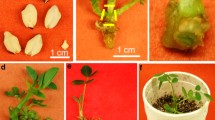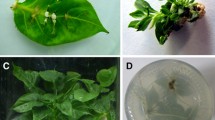Abstract.
Genetic transformation of peppermint is known to be very difficult essentially because of low efficiency regeneration. A regeneration protocol allowing 51% shooting frequency is proposed. Transient β-glucuronidase expression and adjustment of selection pressure with kanamycin are also reported. The final retained method to attempt peppermint transformation is: Agrobacterium inoculation or biolistic treatment of the first apical leaves of in vitro clones, regeneration in the dark with kanamycin (1 mg l–1) and 6-benzylaminopurine (2 mg l–1), followed by selection of regenerated shoots with 200 mg l–1 kanamycin.
Similar content being viewed by others
Author information
Authors and Affiliations
Additional information
Received 20 December 1995/Revised version received 28 February 1996 – Communicated by N. Amrhein
Rights and permissions
About this article
Cite this article
Caissard, JC., Faure, O., Jullien, F. et al. Direct regeneration in vitro and transient GUS expression in Mentha×piperita . Plant Cell Reports 16, 67–70 (1996). https://doi.org/10.1007/s002990050178
Issue Date:
DOI: https://doi.org/10.1007/s002990050178




